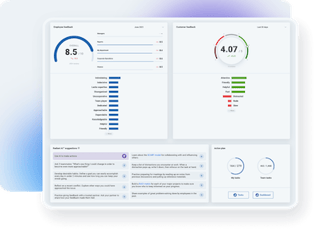
10 Features You Should Look for in an Employee Survey
According to Gallup research, only one in four employees are engaged, making it important to leverage tools that can move the engagement needle in a positive direction. The employee survey is a highly effective tool for gathering data to measure and improve engagement. Whether your organization has 50 employees or 50,000, an employee survey can transform the entire organization and pave the way for a more engaged workforce.
Top-performing businesses recognize the challenges of engaging modern employees, including managing workers in remote and hybrid positions and communicating learning objectives to a multi-generational workforce. In response to these changes, employee surveys have evolved from annual performance assessments to inclusive opportunities for skill development and employee recognition.
Today’s employee surveys can do more and reveal more about employee engagement and performance than ever before. With the help of employee survey software, it’s possible to deliver comprehensive surveys to employees no matter where they’re located or what device they use. The power of employee feedback helps develop leaders, address concerns, and improve company culture. Here are ten features you should look for in your next employee survey software:

1. Focused on the Employee Experience
The best way to understand employee engagement is to ask employees. Conventional surveys help managers gauge their employees' feelings about their work environment, compensation level, and upskilling opportunities. While this provides a useful baseline assessment, the modern employee experience is more complex. Whether employees remain productive and committed to their current role also depends on the quality of their workplace connections, their shared cultural values, and their perception of their career goals. By asking targeted survey questions that get at the heart of the employee experience, you can fully understand just how engaged employees are and examine trends that tell you how to make changes to improve engagement.
It’s also important to understand the impact leadership has on engagement levels within your organization. When employees feel that their leaders are committed to shared cultural values, they are 10.5 times more likely to connect to their organization’s culture, which makes them nearly 4 times as likely to be engaged. Knowing that only 27% of employees believe their leaders share their values, organizations are turning to more advanced survey feedback tools to enhance their ability to gauge employee experiences and deploy effective strategies to improve them.
One of these strategies acknowledges shared values and focuses on how they can be applied to the employee’s experience. With software that can tailor surveys to an individual’s career history and goals, businesses can help employees feel that leaders are invested in their development. By efficiently organizing and analyzing large amounts of employee performance data, these improved performance surveys communicate a commitment to individual development, which boosts job satisfaction and engagement, especially in the younger generations of workers.

2. Unfiltered Feedback
Managers, especially those at senior levels, don’t always get the full story about employee work experiences. As such, perceptions of managerial bias can also reduce the effectiveness of performance surveys by making employees feel unrecognized or unfairly judged. In 2024, employers list productivity challenges as the biggest risk to employee/employer trust, with 60% of employees reporting that their employers express different levels of trust for employees depending on their work model. As a result of this distrust, employees are less likely to offer their own unfiltered feedback, preventing managers from getting a clear picture of their employees’ concerns and leading to even greater strategic challenges.
The beauty of employee surveys is that they have the ability to deliver the full, unfiltered truth. Modern feedback surveys address these traditional survey issues by using advanced AI algorithms to generate performance reviews free of managerial bias. These can be delivered to employees on dedicated digital channels and consolidated for managers into an easy-to-use dashboard. With a centralized survey system, management no longer has to interpret secondhand feedback to guess the engagement and satisfaction level of their workforce. Instead, employees feel free to offer their unfiltered experiences, which leads to better engagement strategies.
With a system of unfiltered feedback at their disposal, employees gain trust in their leadership. This makes them more likely to engage in productive one-on-one discussions with their managers that honestly address the concerns that prevent them from reaching their full potential. Instead of translating feedback from unreliable sources, managers with employee feedback systems in place that give and receive unfiltered feedback can gain the trust and participation of their employees while protecting themselves from liabilities.
3. 360-degree Feedback Capability
Employee surveys aren’t just tools to collect one-way feedback; they can be expanded to enable 360-degree feedback as well. With the benefit of feedback from peers, managers, and direct reports, a 360 employee survey provides company managers with rich data that can highlight employees who are struggling or excelling in specific areas. For example, collective 360 feedback surveys can identify employees who are struggling to communicate effectively with members of their team, or managers who are struggling to inspire their teams. A survey score report delivered to both employee and manager identifies the problem so that they can work together to identify a solution such as training or mentoring.
It’s not always easy to see where the best leaders are within the organization. Employee surveys provide a clear view of leadership strengths across the organization. For example, an employee survey can identify a manager who received high ratings from her direct reports for improving team dynamics, as well as managers who are highly respected by members of another department. 360-degree feedback brings leader capabilities into focus, supporting decisions leading to future promotions or expanded management responsibilities.
4. Feedback for Every Employee
A comprehensive feedback system helps HR managers understand how employees work together. In fact, research has shown that feedback from others—managers, peers, direct reports, coworkers from other departments—helps people become more effective overall. With every employee able to give and receive feedback on their experiences and the performance of their peers, managers can create more effective engagement strategies that target the individual’s expectations and career goals.
According to Gallup, peer feedback is particularly effective at boosting performance by strengthening employee relationships and encouraging interdepartmental collaboration. Peer feedback takes the pressure off HR to be the sole source of employee criticism by empowering employees to improve each other and themselves. With detailed feedback coming in from multiple sources, employees receive a more detailed understanding of how their behavior impacts their peers, their managers, and their performance.
When every employee receives 360-degree feedback, they gain the tools to build on their strengths while addressing areas of concern. When deployed using modern employee survey software, this can lead to a more inclusive workplace where every employee feels that their voice is valued. They can even leave feedback on their managers’ performance, expanding the scope of their impact on their workplace environment.
5. Integration of Technology and AI
With outdated technology wasting nearly an hour of the workday on average for every employee, 75% of employees report feeling less motivated and productive due to struggling with these systems. Top-performing businesses are turning to advanced cloud-based software solutions with AI-enhanced survey processes to improve data collection, performance analysis, and productivity in their HR departments.
AI and machine learning enhance the feedback experience in numerous ways, including:
- Providing real-time feedback on recent work, which has been proven to be more effective than less frequent assessments
- Generating individualized feedback surveys using clear language that communicates shared career development goals between managers and employees
- Highlighting employee challenges based on organized historical data, free of managerial bias
- Providing skill acquisition opportunities to increase engagement and reduce turnover
Delivering high-quality recognition in employee feedback remains a top priority for managers struggling with post-pandemic turnover rates. In Gallup's 2023 report, Empowering Workplace Culture Through Recognition, great feedback is defined as authentic, timely, personalized, fair, and integrated into workplace culture. AI-enabled employee survey software helps businesses identify and respond to gaps in their feedback strategy with unified data collection and performance management systems.
6. Work-Life Balance and Flexibility
According to the Society for Human Resources Management (SHRM), an increase in flexible work models has led to greater feelings of stress and isolation in remote and hybrid employees. As more employees desire remote work options, top-performing businesses search for ways to provide a better work-life balance for their employees.
By offering learning and feedback systems that employees can access anywhere and on any device, businesses empower their workers to have more control over their learning schedule. HR leaders can connect with employees more easily, especially those in remote work settings, and teams can collaborate more efficiently on the business’s centralized feedback platform.
However, achieving a work-life balance and reducing employee stress requires more than L&D access. Employee engagement software also needs to remain flexible, offering personalized career development resources to guide employees toward their goals based on insights into their individual experiences. Selecting a platform that integrates within daily workflows and common workforce management tools like Slack and Microsoft Teams, gives HR leaders the means to keep their employees connected and encouraged even while working remotely.
7. Continuous Feedback Loops
In the past, HR managers have relied on annual performance reviews to react to engagement issues and assess employee satisfaction. However, the gap between the employee’s achievement and the review made it difficult to meaningfully improve productivity. Industry leaders are replacing annual surveys with continuous feedback loops to address engagement challenges proactively, helping individuals achieve their potential by valuing their experiences and responding efficiently to their concerns.
According to recent Gallup data, employees who receive timely recognition are 20 times more likely to be engaged. Acknowledging recent feedback makes employees feel recognized and motivated to continue performing well. This continuous feedback loop presents a clear upskilling path for them to follow that isolates their personal shortcomings to help them improve. Managers can use technology in employee surveys to organize performance data into ongoing feedback that encourages growth opportunities in their 1:1s and leads to global strategies that lower turnover rates by helping employees stay in the feedback loop.
8. Support for Employee Retention
Past studies have shown nearly one in three employees say they have a coworker who makes them want to quit. Factors such as manager behavior, lack of career growth, and company culture also contribute to employee turnover. Turnover is a reality for every organization, but it doesn’t have to be unmanageably high. Employee surveys deliver feedback that explains why good people quit. An employee survey can identify individuals who are growing frustrated by a lack of accountability within their team. It can also uncover high-potential employees who can be retained with stretch assignments, job rotations, or mentors.
Losing a great employee hurts organizational productivity and leaves a gap that is often difficult to fill. Employee surveys support employee retention in the following ways:
- Survey questions can identify the degree to which people are considering leaving (e.g., “How likely is it that you will be working here one year from now?”).
- Survey results provide opportunities to have in-depth conversations with employees about how to retain them.
- Feedback delivered to every manager helps them learn what to do (or stop doing) to retain the people on their team.
9. People-First Culture
Effective employee surveys encourage a people-first culture that prioritizes well-being, social responsibility, and diversity. In today’s HR landscape, businesses must promote inclusive practices beyond simply mentioning DEI keywords in training videos. The actions of management and the availability of feedback must support gender equality and diversity within departments and across the business as a whole.
Creating a people-first culture begins with effective communication where employees always feel valued and in the loop, with easy access to learning and development resources tailored to their career goals. Diversity training, employee resources groups, and departmental workshops can contribute to employee well-being. They promote an environment that values all voices equally, distributes feedback fairly, and educates workers on inclusive practices in the modern workplace.
10. Purpose and Meaning
With feedback collected and received from multiple channels, HR leaders must ensure that employees understand the purpose and meaning of the results. Without a clear purpose, regular, real-time feedback can become overwhelming. Team leaders may fail to identify struggling employees by adding to the communication breakdown with redundant assessments.
To overcome this, your employee surveys should measure the connection between an employee’s career goals and actual experiences. This can be achieved by identifying common retention and loyalty factors, measuring their career progress, and searching for engagement patterns in their historical survey responses. Advanced software can easily identify an employee’s feelings about their company culture, employer reputation, and personal contributions to their workplace. This helps managers communicate the purpose of their work and how it relates to their career development, the experiences of their co-workers, and the company’s mission as a whole.
Conclusion
By understanding how their current work relates to their career advancement, employees are more likely to remain loyal. This loyalty helps businesses save on the significant costs associated with recruiting, hiring, and training new workers, especially in industries where lack of employee satisfaction drives high turnover rates. By investing in the employee survey features that make the biggest positive impact on productivity and engagement, businesses can cultivate a satisfied, autonomous workforce without the need for additional HR personnel or costly training resources.
Learn how companies are using Macorva to enhance employee engagement and satisfaction, all while staying within budget. Create a people-first environment of continuous learning that attracts and retains talent. Contact us today to get started.
Editors note: this blog was originally published in May 2019 and has been updated for accuracy and comprehensiveness.





